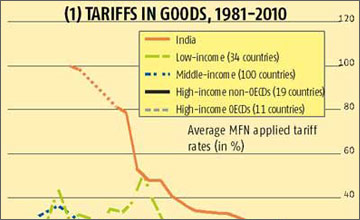The question on whether India is an open or a closed economy depends on whether “openness”, according to Arvind Subramanian of the Peterson Institute for International Economics, is measured by trade policy or by actual trade outcomes. While India’s trade policy barriers were high prior to 1991, they have declined significantly to almost 10 percent today and have almost converged with tariffs in the rest of the world. In contrast, barriers are very high in services. However, when the country’s trade regime is evaluated in terms of trade outcomes (trade-to-GDP ratio), it has doubled over the course of a decade from 25 to 53 per cent in 2012.
Read More>>



